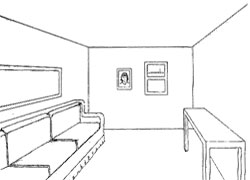

Single or one point perspective is the foundation of all drawing.
MATERIALS LIST
Hover Or Click
A Color For Information
Burnt Sienna
A sedimentary color; sediments quickly offering a mottled or shimmery look to the final (wash)
+ close +Viridian
A sedimentary color; sediments quickly offering a mottled or shimmery look to the final (wash)
+ close +Pthalocyanine Blue
A "warm" (greenish) blue.
A non sedimentary color settles out smoothly yielding a uniform finish (wash)
+ close +Pyrrol Red
A "warm" (orangish) red.
A non sedimentary color settles out smoothly yielding a uniform finish (wash)
+ close +Arylide Yellow FGL
A "warm" (orangish) yellow.
A non sedimentary color settles out smoothly yielding a uniform finish (wash)
There is not an industry standard name for this color. I am offering DaVincis Brand name.
+ close +Yellow Ocher
A sedimentary color.
sediments quickly offering a mottled or shimmery look to the final (wash)
+ close +Cerulean Blue
A sedimentary color.
Sediments quickly offering a mottled or shimmery look to the final (wash)
+ close +Ultramarine Blue
A cool (purplish) blue.
A non sedimentary color settles out smoothly, theoretically yielding a uniform final (wash).
Actually Ultramarine Blue "flocculates" (gathers in clumps) so we only get a fairly smooth (wash)
Sadly, it's the only purplish blue thats light-fast and available to artists.
+ close +Alizarin Crimson
( Quinacridone )
A cool (purplish) red.
A non sedimentary color settles out smoothly yielding a uniform finish (wash)
n fact, Alizarine Crimson (a very early man made pigment) lost favor when it was found non light-fast.
Today we replace it it with a better version of the same color called Quinacdridone Red.
Nevertheless, manufacturers still call it Alizerine Crimson.
+ close +A cool (greenish) yellow
A non sedimentary color settles out smoothly yielding a uniform finish (wash)
There is not an industry standard name for this color. I am offering the DaVincis Brand name.
+ close +Drawing Lesson # 1
Elementary Drawing Skills
Single Point Perspective
There are so many different types of perspective systems for drawing and painting.
Atmospheric or atmospheric perspective: Illustrated in the lesson (Landscape Shadows)
Oriental painting uses a progression of objects from front (bottom) to back (top).
Even a Mercator projection is a form of perspective.
Since the invention of linear perspective, during the Renaissance, it has dominated world art.
The only tool you need to do this is a straight-edge
There are many systems for portraying depth within a painting., but none more effective than linear perspective. Linear perspective produces the image you would see in a photograph. The lens takes a three dimensional scene and presents it to us on a two dimensional surface. I find it interesting that the Human Species has been around in its current condition for 20,000 - 40,000 years. They have been making arts the whole time. Nevertheless, it took until the Renaissance for someone to figure out the very simple rules of linear perspective.
The actual lesson can be distilled down to one sentence:
In perspective drawing, all parallel lines converge at a single point.
That may sound simple, but it is so counterintuitive that I spend more than fifteen minutes in this perspective drawing just to try to convey this one little statement.
 Drawing Lesson One -(Single) One Point Perspective
Drawing Lesson One -(Single) One Point Perspective
 Drawing Lesson Two - Three Point Perspective
Drawing Lesson Two - Three Point Perspective
 Drawing Lesson Three - How TO Draw Round Objects
Drawing Lesson Three - How TO Draw Round Objects
